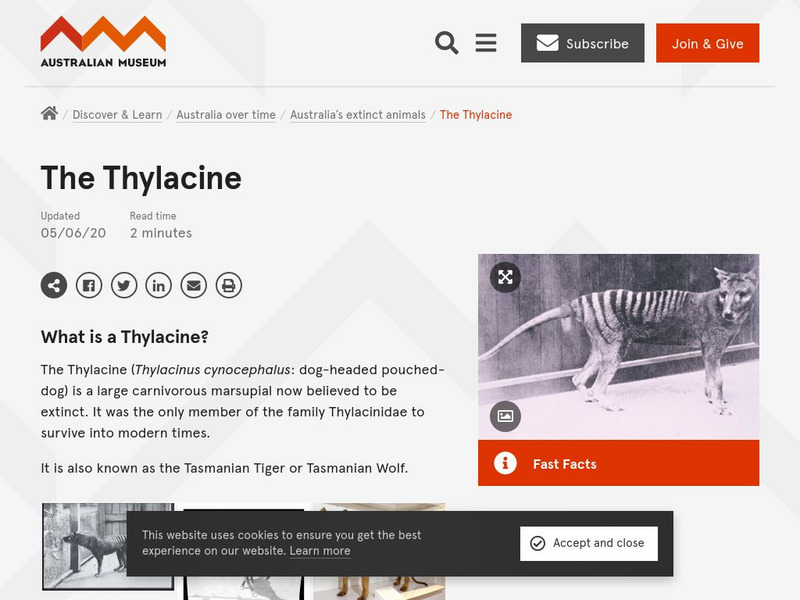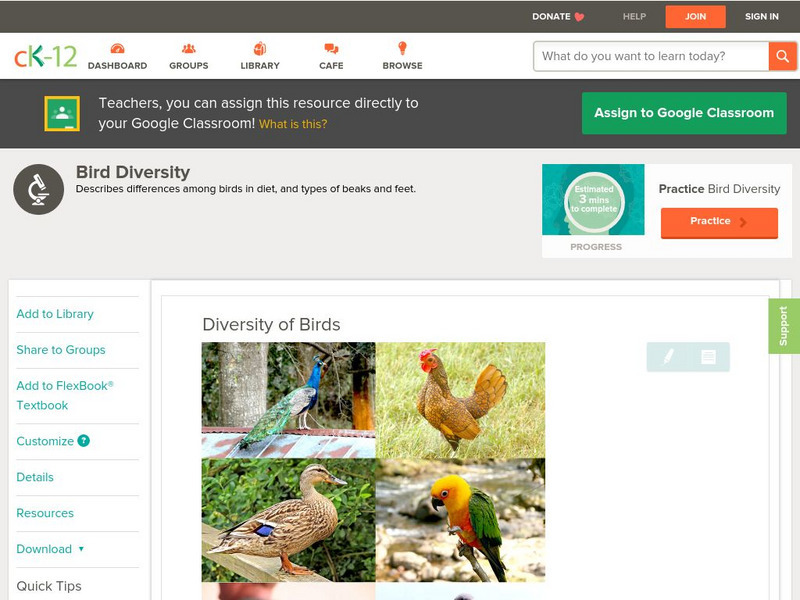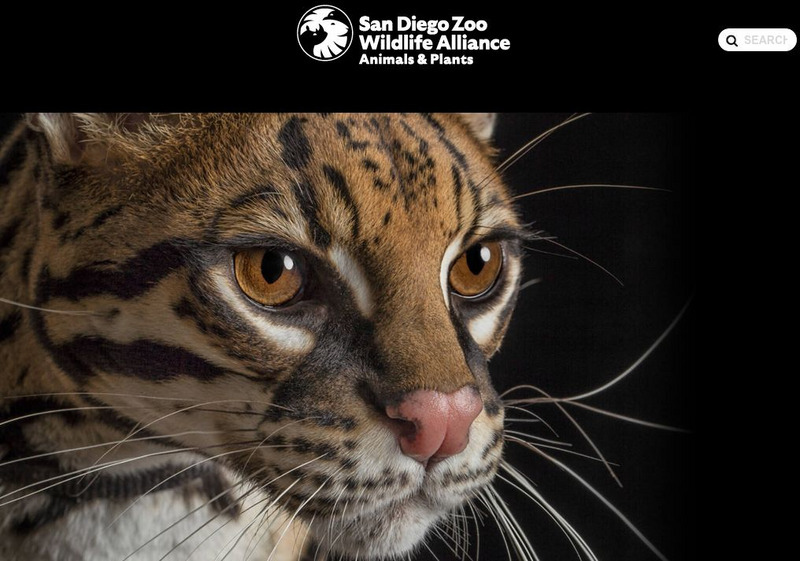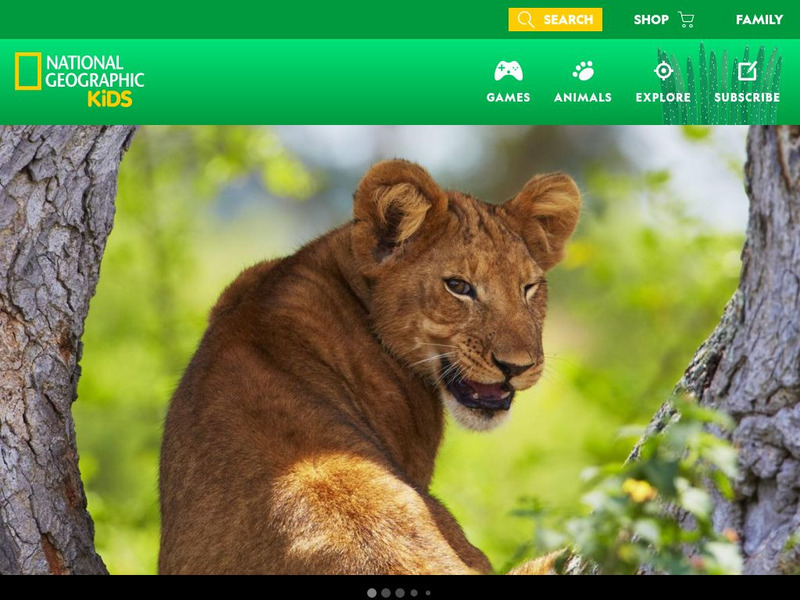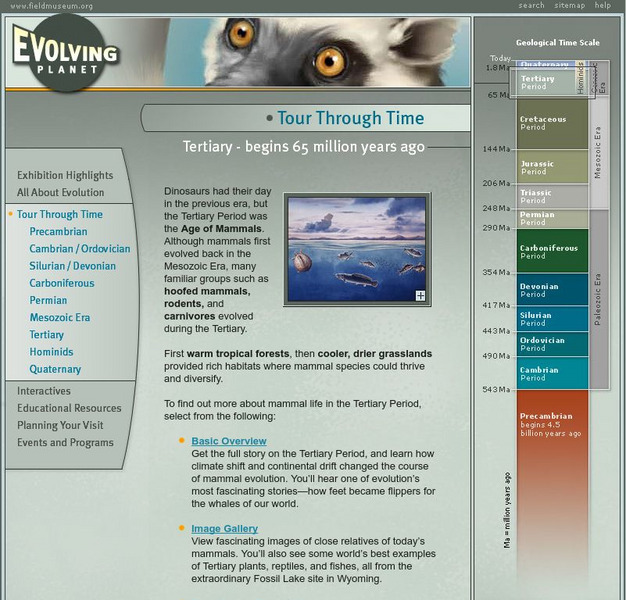Other
New Mexico Museum of Natural History and Science: Coelophysis
The Coelophysis is New Mexico's official state fossil. It lived in the late Triassic Period and has only been found in New Mexico. Popular questions about this dinosaur are answered here. In addition, there are numerous documents about...
PBS
Pbs Learning Media: Dinosaur Train
Dinosaur Train sparks children's interest in life science and natural history. As they explore a variety of animals, children develop the inquiry skills and knowledge needed to help them think, talk and act like paleontologists. Choose...
Saint Louis Zoo
Saint Louis Zoo: Jaguar
Discover fun facts and learn about the habitat, diet, breeding, appearance, and conservation status of the jaguar.
Saint Louis Zoo
Saint Louis Zoo: Cheetah
Learn animal facts about habitat, behavior, speed, and appetite, and most importantly, discover the threats that these amazing animals face today.
Saint Louis Zoo
Saint Louis Zoo: Snow Leopard
Discover fun facts and learn about the habitat, breeding, appearance, diet, and conservation status of the snow leopard.
Saint Louis Zoo
Saint Louis Zoo: Polar Bear
Discover fun facts and learn about the habitat, appearance, and conservation status of the polar bear.
PBS
Nh Pbs: Nature Works: Long Tailed Weasel
Discover the Long-Tailed Weasel, a small carnivore that lives in various parts of North America. The content of this site includes a look at this species' behavior, characteristics, range, habitat, life cycle, and diet.
TED Talks
Ted: Ted Ed: How Do We Know What Color Dinosaurs Were?
The microraptor was a four-winged carnivorous dinosaur with iridescent black feathers. But if our information about this dinosaur comes from fossils, how can we be certain about its color? Len Bloch shows how making sense of the evidence...
Regents of the University of Michigan
Animal Diversity Web: Jaguar
Comprehensive note about the jaguar includes taxonomic classification, specimens, and details about this carnivorous cat's habitat and role in the ecosystem.
Australian Museum
Australia Museum: Thylacine
The Thylacine, once an inhabitant of Australia is now extinct because of excessive hunting and competition with dingos and dogs. The Australian Museum provides general information on this interesting carnivore and photographs of the last...
BBC
Bbc Nature: Army Ant
Army ants live in Central and South America. They have a completely carnivorous diet. Learn more about the army ant in this well-constructed overview produced by the BBC. This resource includes a series of videos and images showcasing...
Smithsonian Institution
Smithsonian National Zoo: Cheetah
Smithsonian site showcases this striped carnivore. Users are able to view a cheetah cam as well as learn some interesting facts about the cheetah.
CK-12 Foundation
Ck 12: Life Science: Diversity of Birds
[Free Registration/Login may be required to access all resource tools.] About 10,000 bird species belong to 29 different orders within the class Aves. The diversity among birds is striking. Birds can vary greatly in size and color. Some...
TeachEngineering
Teach Engineering: Go With the Energy Flow
Students learn about energy and nutrient flow in various biosphere climates and environments. They learn about herbivores, carnivores, omnivores, food chains and food webs, seeing the interdependence between producers, consumers and...
Wonderville Media
Wonderville: African Lions
The African lion is at the top of the food chain and is often called "the king of the jungle." It is the biggest carnivore in Africa and remains one of the most feared predators on the planet. Lions are well known for their courage and...
Museums Victoria
Melbourne Museum: Meet the Skeletons: Quetzalcoatlus Northropi
Quetzalcoatlus northropi was a carnivorous pterosaur larger than an African elephant. It lived during the Cretaceous Period. Some information and pictures can be found here.
Museums Victoria
Melbourne Museum: Meet the Skeletons: Anhanguera Blittersdorffi
Anhanguera blittersdorffi was a carnivorous pterosaur that lived during the Cretaceous Period. Some information and pictures can be found here.
Scholastic
Scholastic Explorers: Endangered Ecosystems
A great site with something for all grades. Do research on rainforests, follow field research on animals in Latin America, and show what you know through interactive assessments. Lots to see on this site which is a collaboration of...
PBS
Idaho Public Television: Birds of Prey Facts
Dialogue for Kids, a program on Idaho Public Television, offers facts, information, and images of birds of prey. Learn what makes a bird a raptor, what raptors look like in the sky, threats that face these birds, and more! Classroom...
San Diego Zoo Global
San Diego Zoo: Leopard
This resource presents detailed information about the leopard, including several photos.
San Diego Zoo Global
San Diego Zoo: Ocelot
An in-depth description of ocelots, including their classification, appearance, habitat, adaptations, reproduction, diet, and other interesting facts. Also includes pictures and sound bytes.
Smithsonian Institution
Smithsonian Environmental Research Center: Forces of Change: Weaving the Web
The young scholars will become the food web in this fun interactive classroom activity. Detailed instructions, background information, guiding questions, and activity worksheets are provided.
National Geographic Kids
National Geographic Kids: Animals: Lions
Students doing research about lions will find this site very helpful. Video and audio clips, photographs, a map, and fun facts will enhance research projects.
The Field Museum
Field Museum: Exhibits: Evolving Planet: Tertiary
Delve into the Tertiary Period portion of the Evolving Planet exhibit, and trace the climate and continental shift during this time. Includes an overview of the period, a collection of images, and a look at the Tertiary Period's...
Other popular searches
- Carnivore +Herbivore(teeth)
- Herbivores Carnivores
- Carnivore Herbivore
- Omnivore Herbivore Carnivore
- Producers and Carnivores
- Herbivores and Carnivores
- Herbivore and Carnivore
- Herbivores. Carnivores
- Herbivore Carnivore Teeth
- Carnivores Omnivore Herbivores




